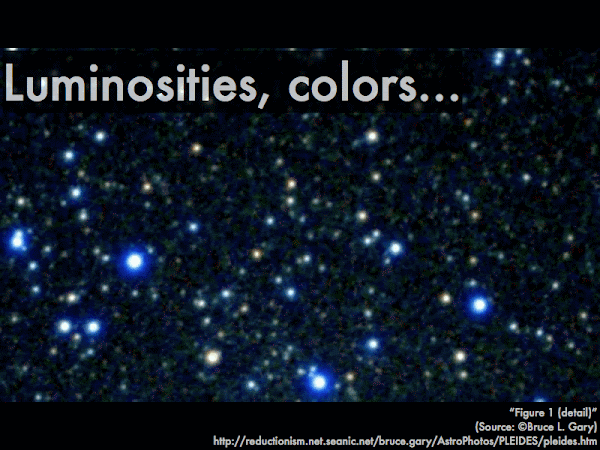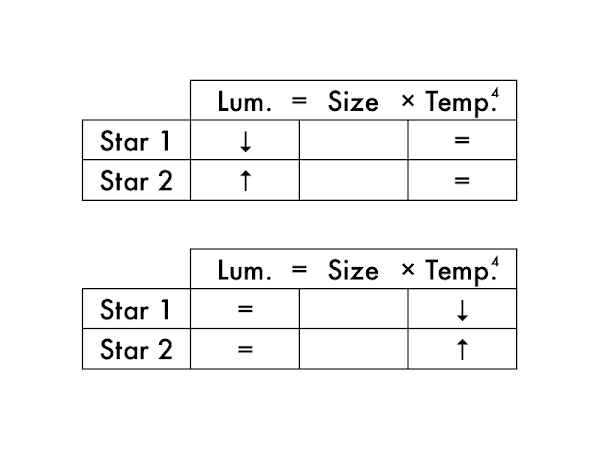Cuesta College, San Luis Obispo, CA
Students have a weekly online reading assignment (hosted by SurveyMonkey.com), where they answer questions based on reading their textbook, material covered in previous lectures, opinion questions, and/or asking (anonymous) questions or making (anonymous) comments. Full credit is given for completing the online reading assignment before next week's lecture, regardless if whether their answers are correct/incorrect. Selected results/questions/comments are addressed by the instructor at the start of the following lecture.
The following questions were asked on reading textbook chapters and previewing presentations on parallax, distance, apparent magnitude, absolute magnitude, Wien's law and the Stefan-Boltzmann law.

Selected/edited responses are given below.
Describe something you found interesting from the assigned textbook reading or presentation preview, and explain why this was personally interesting for you.
"The different spectral classes of the stars, O, B, A, F, G, K, and M. I knew that they were classified because of color and temperature, but I guess I never looked into how they are classified."
"The ratings of stars apparent magnitude and actual magnitude is interesting, because it is cool to rate things."
"The magnitude scale from +1 being the brightest to +6 and up getting dimmer. I understand that it means that the brightest star is in first place and all, but it is still interesting that it's that way."
"A small, really hot star can be as bright as a large star that is less hot."
"How the different colors of stars correlates to their temperatures."
"How to determine brightness interesting because I thought it was a way more difficult process than a mathematical equation."
"That red stars are cool and blue stars are hot. I thought it would be the other way around."
"The method for finding absolute magnitude of a star--moving all the stars to an equal distance of 10 parsecs and seeing which is actually the brightest is pretty cool and shows that the sun is pretty dim."
"How to tell the distance of a star through parallax interesting as I've always wondered how that was figured out."
Describe something you found confusing from the assigned textbook reading or presentation preview, and explain why this was personally confusing for you.
"Trying to keep the laws of the luminosity/temperature/size of all these stars is going to be rather difficult, for me."
"Why is it that the negative numbers in absolute magnitude and apparent magnitude, actually make it brighter?"
"Parsecs, because it's just confusing"
"Nothing, really."
"Honestly I found everything confusing."
"How to measure the distance of stars, I understand that you take two different measurements, but I don't know how the measurements really work."
"I don't understand how parallax works."
"Something that I found confusing was the absolute magnitude. The numbers just threw me off. I did not understand how pushing stars back to 10 parsecs could make things more 'fair.'"
Explain how apparent magnitude and the absolute magnitude are defined differently.
"Apparent: the brightness of a star relative to an observer on Earth. Absolute: the true magnitude of a star, compensating for its distance from the observer on Earth."
"Apparent magnitude is how bright we see the star from Earth. Absolute magnitude is once the star is 10 parsces away from Earth and on an equal distance with the other stars and then judging the true brightness of the stars."
"I have no idea. I need help!!!"
"Absolute measures the actual brightness while the apparent measures the brightness as you see it."
"What it looks like and what it really is."
Suppose the sun was moved to a distance of 10 parsecs away. As a result, its __________ magnitude would become dimmer.
absolute. ******* [12] apparent. ****************** [18] (Both of the above choices.) * [1] (Neither of the above choices.) * [1] (Unsure/guessing/lost/help!) ** [2]

(Only correct responses shown.)
1 (brightest): the sun, m = -27 [85%]
2: Canopus, m = –1 [71%]
3: Vega, m = 0 [77%]
4 (dimmest): Kapteyn's star, m = +9 [71%]
Rank the brightnesses of these stars (1 = brightest, 4 = dimmest; there are no ties), if relocated to 10 parsecs from Earth.
(Only correct responses shown.)
1 (brightest): Canopus, M = -3 [56%]
2: Vega, M = +0.5 [56%]
3: the sun, M = +5 [71%]
4 (dimmest): Kapteyn's star, M = +11 [68%]
Determine the stars that get dimmer or brighter when relocated from their original positions to 10 parsecs from Earth.
(Only correct responses shown.)
The sun: gets dimmer [68%]
Canopus: gets brighter [65%]
Vega: gets dimmer [60%]
Kapteyn's star: gets dimmer [60%]
Rank the temperatures of these main sequence stars (1 = hottest, 4 = coolest; there are no ties).
(Only correct responses shown.)
Hottest: blue main sequence star [65%]
Second hottest: white main sequence star [59%]
Third hottest: yellow main sequence star [77%]
Coolest: red main sequence star [77%]
Rank the temperatures of these supergiant and dwarf stars (1 = hottest, 4 = coolest; there are no ties).
(Only correct responses shown.)
Hottest: blue supergiant [62%]
Second hottest: white dwarf [47%]
Third hottest: yellow supergiant [53%]
Coolest: red dwarf [77%]

dimmer. *** [3] brighter. ************************* [25] (These stars would be the same size.) ** [2] (Unsure/guessing/lost/help!) **** [4]
Two stars (equally far away) have the same brightness, but one star is cooler, and the other star is hotter. The __________ star will be larger in size.
cooler. ************* [13] hotter. ************** [14] (These stars would be the same size.) ** [2] (Unsure/guessing/lost/help!) ***** [5]
Ask the instructor an anonymous question, or make a comment. Selected questions/comments may be discussed in class.
"I like turtles."
"I'm mad at Doctor Who because he traveled to a blue star that was supposed to be the coldest star in the universe. Cold stars aren't blue. Fail."
"When will we do another observation night?" (Next Thursday, weather permitting.)
"The textbook says brown dwarfs are a step above gas giants, so are gas giants just stars that didn't quite make it?" (In a way, yes. Stars fuse hydrogen into helium in their cores; this requires a lot of gravitational forces in their cores, so stars need to have a certain amount of mass in order to do this. Brown dwarfs don't have enough mass (and gravity) to fuse hydrogen into helium, but they can fuse hydrogen into deuterium, which is a step down from helium. And a gas giant planet is also made of hydrogen, but does not have enough mass (and gravity) to fuse its hydrogen into anything at all, so it will just stay that way.)
No comments:
Post a Comment